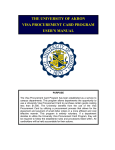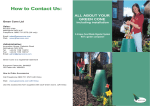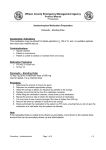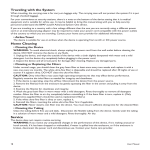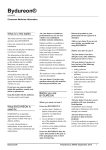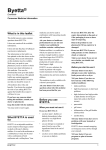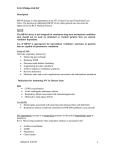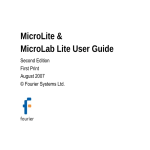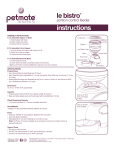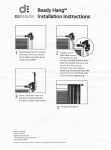Download Total Face CPAP Mask User Instructions
Transcript
E n g li s h Instructions for Use Total Face Mask Intended Use The Total Face Mask is intended to provide an interface for application of CPAP or bi-level therapy to patients. The mask is for single patient use in the home or multi-patient use in the hospital/institutional environment. The mask is to be used on patients (>66lbs/30kg) for whom CPAP or bi-level therapy has been prescribed. Important: An exhalation port is built into the Total Face Mask so a separate exhalation port is not required. Caution: U. S. federal law restricts this device to sale by or on the order of a physician. Symbols Warning or Caution Note Does not contain natural rubber latex Tip Consult instructions for use Leak symbol and value Contains PHT (phthalates) Warnings: •• This mask is not suitable for providing life support ventilation. •• This mask is designed for use with CPAP or bi-level systems recommended by your health care professional or respiratory therapist. Do not wear this mask unless the CPAP or bi-level system is turned on and operating properly. Do not block or try to seal the exhalation port. Explanation of the Warning: CPAP systems are intended to be used with special masks with connectors which have vent holes to allow continuous flow of air out of the mask. When the CPAP machine is turned on and functioning properly, new air from the CPAP machine flushes the exhaled air out through the attached mask exhalation port. However, when the CPAP machine is not operating, enough fresh air will not be provided through the mask, and exhaled air may be rebreathed. This warning applies to most models of CPAP systems. Rebreathing of exhaled air for longer than several minutes can, in some circumstances, lead to suffocation. •• If oxygen is used with the device, the oxygen flow must be turned off when the device is not operating. Explanation of the Warning: When the device is not in operation, and the oxygen flow is left on, oxygen delivered into the ventilator tubing may accumulate within the device enclosure. Oxygen accumulated in the device enclosure will create a risk of fire. •• Oxygen supports combustion. Oxygen should not be used while smoking or in the presence of an open flame. •• At a fixed flow rate of supplemental oxygen flow, the inhaled oxygen concentration will vary, depending on the pressure settings, patient breathing pattern, mask selection, and the leak rate. This warning applies to most types of CPAP and bi-level machines. •• Some users may experience skin redness, irritation, or discomfort. If this happens, discontinue use and contact your healthcare professional. •• The entrainment valve contains a magnet. Do not use this mask in or near magnetic resonance imaging (MRI) equipment. •• The patient’s physician should be contacted if the patient experiences the following symptoms while using the masks or after removing it: Unusual chest discomfort, shortness of breath, stomach distension, belching, or severe 1 •• •• •• •• •• •• •• •• headache; drying of the eyes, eye pain, or eye infections; blurred vision. (Consult an ophthalmologist if symptoms persist.) At low CPAP or EPAP pressures the flow through the exhalation port may be inadequate to clear all exhaled gas from the tubing. Some rebreathing may occur. A minimum of 5 cm H2O (hPa) must be maintained when using this mask. This mask should not be used on patients who are uncooperative, obtunded, unresponsive, or unable to remove the mask. This mask is not recommended if the patient is taking a prescription drug that may cause vomiting. If an additional exhalation device is added to the patient circuit, youmay need to adjust the pressure level to compensate for the additional leak of the exhalation device. Use of a nasal or full face mask may cause tooth, gum, or jaw soreness or aggravate an existing dental condition. Consult your physician or dentist if symptoms occur. Do not block or try to seal the entrainment valve. This product may contain chemcials (phthalates) which may cause adverse health effects. If you are pregnant or breast feeding, contact your healthcare professional before use. Contraindications This mask may not be suitable for use on patients with the following conditions: glaucoma, recent eye surgery or dry eyes, nocturnal vomiting, hiatal hernia, impaired cardiac sphincter function, excessive reflux, impaired cough reflex, or on patients unable to remove the mask by themselves. Cleaning Instructions for the Mask For Multi-Patient Use Reusable. See the disinfection instructions later in this document. Clean all parts of the mask daily. Clean the headgear at least once each week or more often if needed. Remove headgear before cleaning. 1. Hand wash the mask with a soft bristle brush in cool tap water with a mild dishwashing detergent. Caution: Use a mild liquid dishwashing detergent only. Do not use bleach, alcohol, or cleaning A solutions containing bleach or alcohol, A B or cleaning solutions containing B C C conditioners or moisturizers. D F 2. Rinse thoroughly. Air dry. Make sure D the mask is dry before use. E E 3. If any parts are damaged or can not be cleaned, replace the mask. Figure 2 Figure 1 Cleaning Instructions for the Headgear A = Faceplate 1. Hand or machine wash with a standard A = Entrainment Valve B = Entrainment Valve (Do not block opening) laundry detergent and warm water. (Do not block) B = Entrainment Valve Rinse thoroughly. Do not use bleach. C = Accessory Swivel Flapper 2. Line dry or machine dry at the medium C = Flapper Closed D = Exhalation Ports heat setting. E = Pressure Pickoff Port D = Flapper Open 2 Cap E = Accessory Swivel Verifying Entrainment Valve Function F = Headgear Hooks With the unit turned off, the entrainment valve flapper (internal blue disk) should be open, allowing the user to breathe room air (Figure 1-D). Turn the unit On. The flapper should close, allowing the user to receive airflow from the unit. If the valve still does not function properly, notify your home care dealer. Do not block the opening on the entrainment valve. Check the valve before each use for dysfunction or any blockage by patient secretions. To ensure proper entrainment valve function, verify that the flapper is free moving and dry. Leak Symbol and Port Settings Some ventilators may incorporate the use of a leak symbol and value in the mask selection setup procedures. The leak characteristics of this mask is leak symbol ( ). The leak symbol and value represents the intentional leak characteristics of the interface. On ventilators equipped with a Mask Selection control, enter the leak symbol value ( ) that corresponds with the leak symbol value on the mask. Achieving the Right Fit 1. Set up the CPAP or BiPAP unit and patient circuit according to the unit’s instruction manual. 2. To ensure a proper fit, place the patient’s chin in the mask first, then lightly press the mask against the patient’s face. 3. Pull the headgear straps around each side of the head and secure them to the mask. Note: Do not overtighten the straps. Overtightening can cause or worsen leaks. 4. Connect the circuit tubing to the mask swivel (Figure 2-C). Turn the CPAP or BiPAP unit on. 5. Verify that there is only minor lifting of the mask from the patient’s face (approximately 1/4” to 1/2”) during a full respiratory cycle. Have the patient assume various sleeping positions (e.g., supine, lateral, prone) with the mask in place. Readjust the straps if necessary. If the inner flap covers the mouth, readjust the mask fit. Removing the Mask and Headgear To remove the mask quickly, pull on the quick release cord, away from the patient’s face, and remove the mask. The mask and headgear can also be removed by detaching the headgear straps from the tabs on the mask. Comfort Tips •• Clean the mask thoroughly before every use, including first-time usage. •• Clean the patient’s face thoroughly before each use. •• Make sure the mask and headgear are the correct size for the patient’s face. If excessive discomfort is experienced, have the mask readjusted or consider an alternative mask. •• Do not overtighten the headgear. Overtightening can irritate the patient’s face, increase leaks, or cause damage to the cushion. Disposal Dispose of in accordance with local regulations. Specifications Warning: The technical specifications of the mask are provided for your healthcare professional to determine if it is compatible with your CPAP or bi-level therapy device. If used outside these specifications, or if used with incompatible devices, the mask may be uncomfortable, the seal of the mask may not be effective, optimum therapy may not be achieved, and leak, or variation in the rate of leak, may affect device function. 3 Intentional Leak 100 80 Flow (slpm) ï 60 Respironics Total Face Mask with Disposable Circuit Respironics Total Face Mask with Whisper Swivel II 40 Respironics Total Face Mask 20 0 Whisper Swivel II 0 2.5 5 10 15 20 Pressure (cm H2O) Deadspace The total volume of the mask is 1500 cc. The volume of the area around the nose piece and entrainment valve where most of the gas exchange occurs is 80 cc. Disinfection Clean all parts of the mask before disinfecting it as described below. Pasteurization Temperature: 70°C Exposure time: 30 minutes Result: High level disinfection Maximum allowable cleaning cycles: 10 •• If the swivel does not move freely after disinfection, replace the sealing ring (part no. 452072). •• Verify function of the flapper valve after processing. If the flapper does not move freely, replace the mask. •• Inspect the mask after processing. If any componenets are damaged, replace the mask. CIDEX Exposure time: 45 minutes Rinse: Per manufacturer’s instructions Result: High level disinfection Maximum allowable cleaning cycles: 10 •• If the swivel does not move freely after disinfection, replace the sealing ring (part no. 452072). •• Verify function of the flapper valve after processing. If the flapper does not move freely, replace the mask. •• Inspect the mask after processing. If any componenets are damaged, replace the mask. •• Slight discoloration of the mask cushion after processing is normal. 4 CIDEX O.P.A. Exposure time: 12 minutes Rinse: Per manufacturer’s instructions Result: High level disinfection Maximum allowable cleaning cycles: 10 •• If the swivel does not move freely after disinfection, replace the sealing ring (part no. 452072). •• Verify function of the flapper valve after processing. If the flapper does not move freely, replace the mask. •• Inspect the mask after processing. If any componenets are damaged, replace the mask. •• Slight discoloration of the mask cushion after processing is normal. STERRAD System 100 Exposure time: Machine controlled Result: Sterilization Maximum allowable cleaning cycles: 10 •• If the swivel does not move freely after disinfection, replace the sealing ring (part no. 452072). •• Verify function of the flapper valve after processing. If the flapper does not move freely, replace the mask. •• Inspect the mask after processing. If any componenets are damaged, replace the mask. •• A slight odor may be present after processing. This is normal. Murrysville, PA 15668 USA 1071629 JAW 06/25/2010 © 2010 Koninklijke Philips Electronics N.V. All rights reserved. 5






